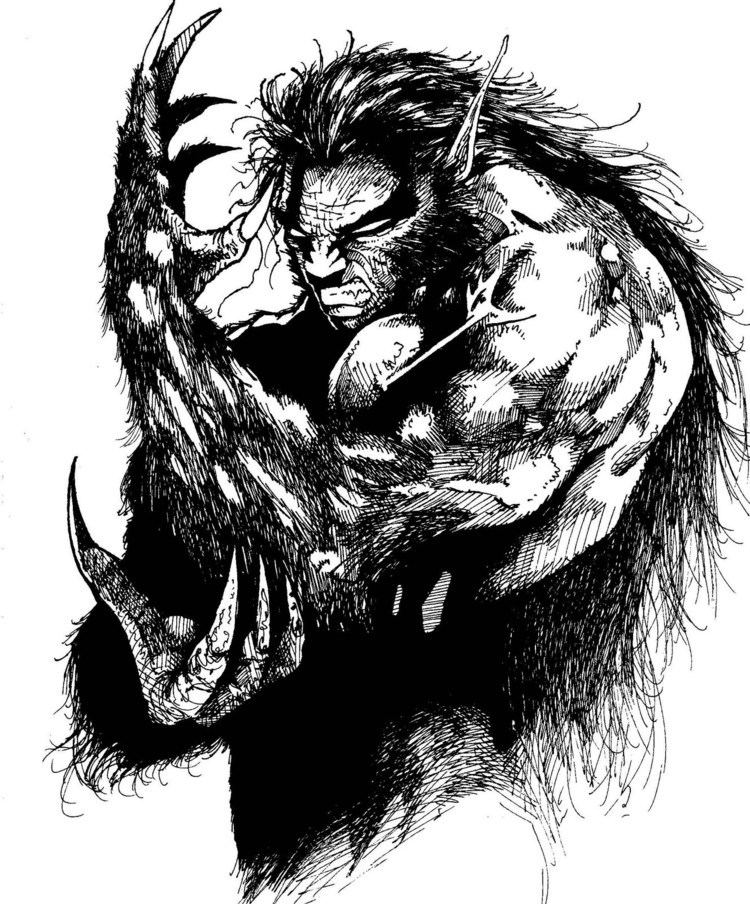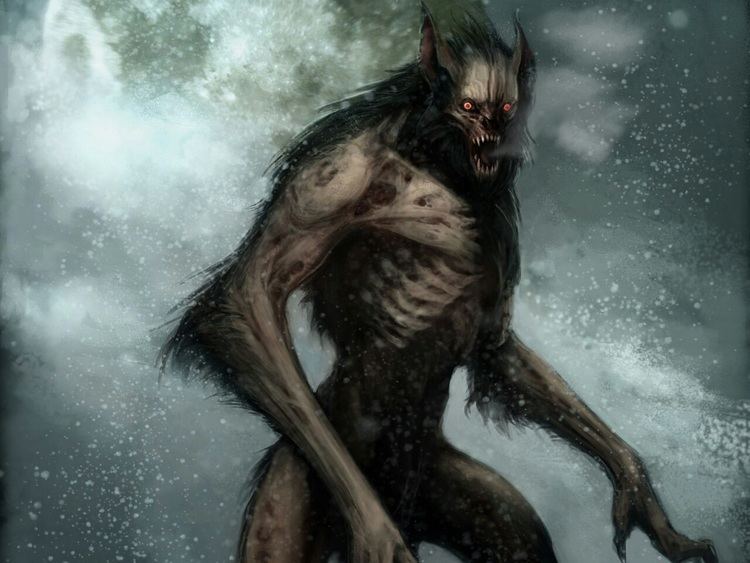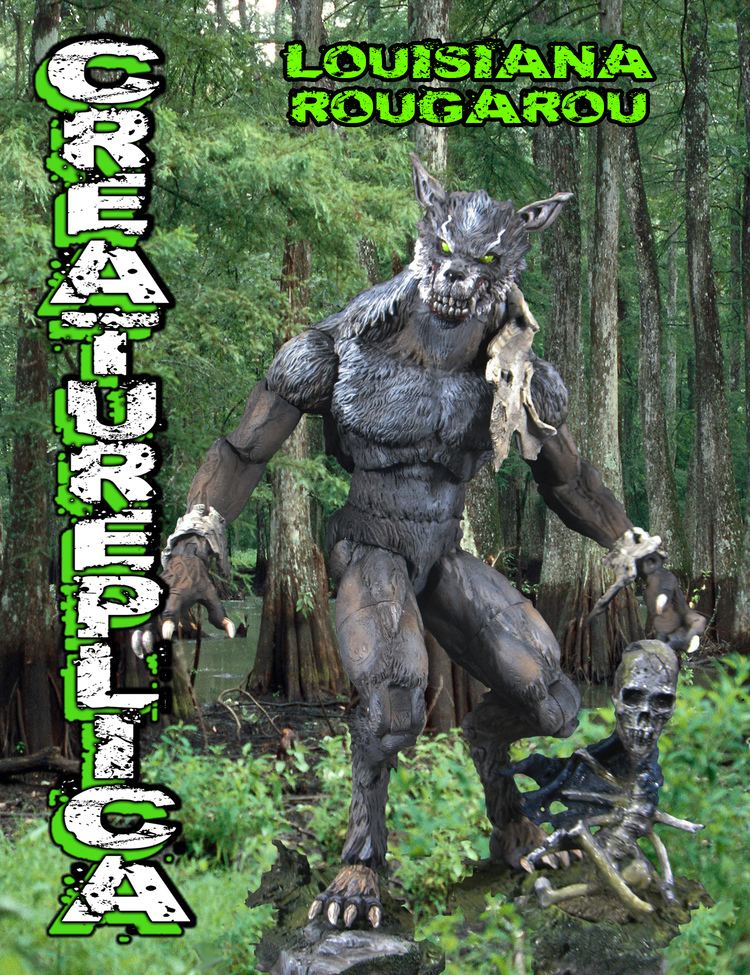 | ||
Similar Wendigo, Bigfoot, Wampus cat, Ruby, John Winchester | ||
Rougarou pov
The rougarou (alternatively spelled as roux-ga-roux, rugaroo, or rugaru) is a legendary creature in Laurentian French communities linked to European notions of the werewolf.
Contents
- Rougarou pov
- The legend of the rougarou
- Versions
- American folklore
- Native AmericanFirst Nation folklore
- In popular culture
- References

The legend of the rougarou
Versions

The stories of the creature known as a rougarou are as diverse as the spelling of its name, though they are all connected to francophone cultures through a common derived belief in the loup-garou (French pronunciation: [lu ɡaˈʁu], /ˈluː ɡəˈruː/). Loup is French for wolf, and garou (from Frankish garulf, cognate with English werewolf) is a man who transforms into an animal.
American folklore

Rougarou represents a variant pronunciation and spelling of the original French loup-garou. According to Barry Jean Ancelet, an academic expert on Cajun folklore and professor at the University of Louisiana at Lafayette in America, the tale of the rougarou is a common legend across French Louisiana. Both words are used interchangeably in southern Louisiana. Some people call the monster rougarou; others refer to it as the loup-garou.

The rougarou legend has been spread for many generations, either directly from French settlers to Louisiana (New France) or via the French Canadian immigrants centuries ago.

In the Cajun legends, the creature is said to prowl the swamps around Acadiana and Greater New Orleans, and possibly the fields or forests of the regions. The rougarou most often is described as a creature with a human body and the head of a wolf or dog, similar to the werewolf legend.

Often the story-telling has been used to inspire fear and obedience. One such example is stories that have been told by elders to persuade Cajun children to behave. According to another variation, the wolf-like beast will hunt down and kill Catholics who do not follow the rules of Lent. This coincides with the French Catholic loup-garou stories, according to which the method for turning into a werewolf is to break Lent seven years in a row.
A common blood sucking legend says that the rougarou is under the spell for 101 days. After that time, the curse is transferred from person to person when the rougarou draws another human’s blood. During that day the creature returns to human form. Although acting sickly, the human refrains from telling others of the situation for fear of being killed.
Other stories range from the rougarou as a rabbit to the rougarou being derived from witchcraft. In the latter claim, only a witch can make a rougarou—either by turning into a wolf herself, or by cursing others with lycanthropy.
Native American/First Nation folklore
The creature, spelled rugaru, derives from Native American/First Nation legends, though there is some dispute. Such folklore versions of the rugaru vary from being mild bigfoot (sasquatch) creatures to cannibalistic Native American or Native Canadian wendigos. Some dispute the connection between these folktales and the francophone rugaru.
As is the norm with legends transmitted by oral tradition, stories often contradict one another. The stories of the wendigo vary by tribe and region, but the most common cause of the change is typically related to cannibalism.
A modified example, not in the original wendigo legends, is that if a person sees a rugaru, that person will be transformed into one. Thereafter, the unfortunate victim will be doomed to wander in the form of this monster. That rugaru story bears some resemblance to a Native American version of the wendigo legend related in a short story by Algernon Blackwood. In Blackwood's fictional adaptation of the legend, seeing a wendigo causes one to turn into a wendigo.
It is important to note that rugaru is not a native Ojibwe word, it is in fact, a word in the Métis language Michif meaning "Werewolf". This explains the striking similarity to the French word for werewolf, loup garou.
It's possible the Turtle Mountain Ojibwa or Chippewa in North Dakota in America picked up the French name for "hairy human-like being" from the influence of French Canadian trappers and missionaries with whom they had extensive dealings. Somehow that term also had been referenced to their neighbors' stories of bigfoot.
Author Peter Matthiessen argues that the rugaru is a separate legend from that of the cannibal-like giant wendigo. While the wendigo is feared, he notes that the rugaru is seen as sacred and in tune with Mother Earth, somewhat like bigfoot legends are today.
Though identified with bigfoot, there is little evidence in the indigenous folklore that it is meant to refer the same or a similar creature.
In popular culture
The rougarou are the main shifter creatures in Olivia Leighton's "The Quarter" paranormal romance series.
The Audubon Zoo in New Orleans in America has an exhibit on the rougarou and features a life-sized mannequin of what the rougarou might look like.
Rougarou is also the title of an online literary journal published out of the University of Louisiana at Lafayette.
The NBA team formerly known as the New Orleans Hornets filed for several new name trademarks among which was the Rougarous.
The Rougarou Fest is a festival that celebrates the folklore of the Louisiana bayous. It takes place on the last Saturday in October in Houma, Louisiana.
Dr John's song, "Loop Garoo," was released in 1970. This includes his standard voodoo references, but also seems to refer explicitly to alligator hunting. This same usage was reflected in Swamp People (season 4, episode 24), when the hunters capture a giant gator referred to by locals as rugaroo.
It was probably first heard on television, pronounced as "Lougarog," in the 1970s TV-movie "Moon of the Wolf," starring David Janssen and Barbara Rush.
The creature is featured in an episode of Cajun Justice, an AE Television show. A camp owner alerted authorities and video taped what he suspected to be a Rougarou in the weeds behind his camp.
The rougarou was featured in the Destination America show Monsters and Mysteries in America.
Haven season 4 episode 11, a rougarou is the suspect in some horrific murders featuring hearts being eaten straight out of the victims' chests.
Supernatural Season 4 Episode 4, Metamorphosis, features a rougarou (spelled "rugaru") is the monster-of-the-week. In this the rugaru is passed down through the family, they appear as normal humans until the age of 30, the 'changing' begins as extreme hunger, they eat everything they can get their hands on. Then they move on to raw meat, until finally they get a taste of human flesh and change into a rugaru. It is also said that if they never eat human flesh, then they never change, although the alternative is to live on raw meat. Season 9, Episode 7, Bad Boys, reveals that, in 1995,John Winchester hunted rugarus in upstate New York's Catskill Mountains.
The legend of the rougarou plays a prominent role in the History Channel television series Cryptid: The Swamp Beast. An unknown creature has been mutilating and killing animals and perhaps humans in southern Louisiana; some locals attribute the attacks to a rougarou.
The novel Hagridden by Samuel Snoek-Brown features heavy usage of the Cajun version of the rougarou.
The Strange Angels book series by Lili St. Crow has a main character, Graves, who is a loup-garou.
In the book Fool Moon (The Dresden Files) by Jim Butcher, a loup-garou (an alternative spelling of rougarou) is the main monster.
In late 2014, Cedar Point theme park in Sandusky, Ohio announced plans to renovate the existing Mantis roller coaster into "Rougarou" for the 2015 season.
In Robert Asprin's Griffen McCandles series the main character lives in New Orleans and among the many creatures he has to deal with on a regular basis are some loup-garou.
The 2015 short film Atchafalaya centers around a game warden searching in a Louisiana swamp for a missing person who is hinted to have been taken by a loup-garou. The creature is only vaguely seen in the film with a head resembling a bear.
In Pascalle Lepas' webcomic Wilde Life, the main character and his friends are warned about the rougarou by a witch, who says that if you see one you will become one. The rougarou then hunts him and his friend, a werewolf, through the woods.
J. K. Rowling's Harry Potter universe includes wands that contain rougarou hair as their magical core.
In the 2016 2K game Mafia III, enemy characters can be heard mentioning the Rougarou in Baron Saturday's Fun Park.
